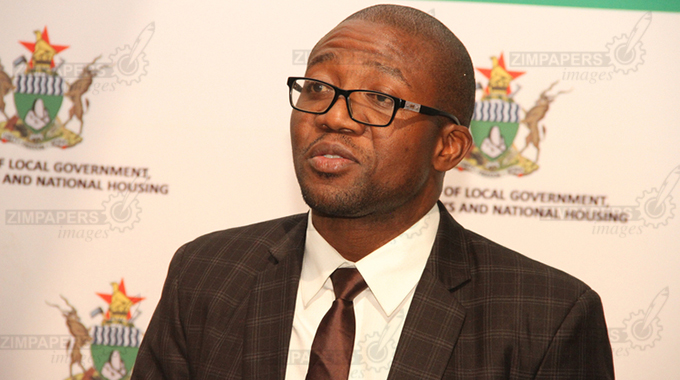‘It took us too long to have our currency back’

The introduction of Statutory Instrument 142 of 2019 on Monday this week has caused a number of developments in the country. SI 142 of 2019 has removed the multiple currency system and reintroduced the Zimbabwe dollar. However, the move has seen producers and retailers, raising prices for goods and services to stratospheric levels, despite the plunge in the parallel market rate for the US dollar against the local currency. Our Deputy News Editor Africa Moyo (AM), yesterday caught up with Industry and Commerce Minister Nqobizitha Mangaliso Ndlovu (NN) on the sidelines of the Zimbabwe National Industrial Development Policy (ZNIDP) launch in Harare, to find out what is going on in industry. For more, read the excerpts . . .
AM: Give us an overview of industry since the coming in of the Second Republic.
NN: When we came in, I found an industry that was on its way up, through SI 64 (of 2016), I think we registered significant gains. We had a number of companies that were coming to invest; your Surface Wilmar, Willowton, your Pepsi; quite a number. Others also retooled because we had protected the industry from imports. But that also came with some problems, specifically to do with regional integration efforts, regional industrialisation efforts; we had diplomatic challenges. Initially, the instrument itself was not meant to last long, it needed to have complementing policies that would sustain industries post beyond the Statutory Instrument. So, yes we then saw in October (2018) what happened, where there was a significant spike in demand, panic buying, prices also going up and to protect the consumers, we had to open up the borders so that they had broader choices. Beyond that, we have seen drought affecting significantly our manufacturing sector particularly from the procurement of raw materials’ point of view, in the face of crippling foreign currency shortages. So we have had in the meantime to speedily conclude the process of coming up with policies that will support sustainable industrial growth, and the two policies — Industrial Policy launched today, as well as local content strategy, speak precisely to that. We believe that there is no country that does not promote their industries, but there are covert protection mechanisms which by and large in the mould of local content policy strategy. As a country we are going to robustly pursue a policy where companies that have a tendency to import that which we have capacity to produce locally, will be faced with high tariffs. Some might not even be able to sell or have those products listed in our shelves. We will have strict listing regulations coming from the local content committee that is going to be set up. So we have really staggered along, we have tried to hang in there.
AM: And as industries try to find their feet, we have recently seen high prices of goods, particularly this week, following the introduction of SI 142 of 2019. What is going on?
NN: The issue of price increases is one factor that is having a huge impact on the industries’ side because aggregate demand has gone down. And my concern is that predominant price increases are not justified. We discussed it here (during the ZNIDP launch), why are we seeing price increases? Should we as Government close borders when I can buy a product 10 times less just across the border because somebody here wants to profiteer? That cannot happen. And this is a clear warning to them that unless we work in partnership, unless we complement each other’s efforts, we will not achieve the goals we have set ourselves. Industry will not realise its potential, there will not grow with this attitude. I had to phone someone from Bakers Inn yesterday (Thursday) when I was in Victoria Falls, a (330ml) can of coke going for $10. And I asked them, how do you justify this? Of course, he found a way of referring me to someone, but the message was clear, we are penalising consumers whom we rely on for our own survival and growth, it doesn’t add up.
AM: Regards price increases, have you scheduled a meeting with retailers to find common ground?
NN: These are ongoing and at this point really they are at director level and they engage weekly, I did not expect what they are doing this week, it’s really misbehaviour if I may put it in that way. The interactions have culminated in what we have seen in the private sector, the millers, the retailers, have come up with monitoring mechanisms where they move around, they send monitors, they have guidelines in terms of pricing models . . . So the discussions are ongoing and I hope that private sector comes to their senses rather sooner.
AM: Give us the latest regards the National Competitiveness Commission, which can bring order in terms of prices.
NN: It’s an important institution and they work closely with the private sector, I am happy this really was an initiative of the private sector. So as Government we have given the green light to set up a secretariat that will spearhead the implementation for monitoring competitiveness and recommending actions to take to both Government and the private sector. As it stands, the process of recruiting the head of the institution is underway I am told the board has identified the people, they have seconded them for clearance. So we should be seeing the institution coming into effect in the next month or so.
AM: Tell us the extent to which SI 142 will impact on industry.
NN: The starting point is that we needed our own currency. In my view, it took too long to come back, but it has come, we are really grateful that we can transact in a local currency.
There is no economy that can withstand the pressure that we found ourselves facing. So firstly, we have seen the parallel market (forex rates) tumbling because it was on the back of speculative tendencies that were not backed by any fundamentals.
Secondly, I expect that our products going forward will be more competitive because the strong currency itself puts us in a disadvantage. What we did not probably realise and adequately plan for, was countering the strong US dollar over the years; not just the strong US dollar, but the attraction of the US dollar. We became a fishing pond of the currency, which is why everyone was dumping (goods).
People literally sold products at break-even point because of the attraction of the US dollar. And that was at the expense of our industry. That is why I am saying it took too long to get us here. Now that we have our own currency, I want to believe we are in a better position to produce products that we can sell.
Even the export market itself; I will tell you confessions from industry and from my ministry; that there was a time when they encouraged industry to export and they were told that I am getting the US dollar here, what do I want from outside? Beyond that, the product would be more expensive here so there was no motivation to export.
That did not grow our aggregate earnings as a nation. So this is correcting a lot of fundamentals that had gone wrong. Primarily we have to look at production, this will have a huge positive impact on our production capacity. So I believe going forward, we are better set.
AM: There are concerns over power outages in the country. What is the impact on industry?
NN: (It’s) quite negatively, severely because we have reduced our manufacturing hours to between eight and 15 (hours) a day and at times even less. So it’s affecting our production capacity, its affecting the cost structure itself because it means for the hours you are not producing, you still incur a cost and you spread it across the few products you are making. But the point I made is how do we move out of this? The starting point; the private sector, companies, mines, owe a cumulative $350 million, most of which really is US dollars to Zesa. How does Zesa pay imported electricity if we are not paying? So from the private sector point of view, I made a clarion call, let us pay bills. Beyond that, let’s look ahead, the power shortages are presenting business opportunities, these are businesspeople. If I were them I would be seeing numerous opportunities, first to cut on the electricity bill for my company, but possibilities of shedding part of it to my colleagues. So certain challenges create opportunities and we will continue with the discourse to explore and exploit the opportunities that are coming.
AM: Tell us if Government is putting up any facilities to support industrial growth.
NN: We will continue to source innovative funding sources. We have Afreximbank, they have hinted on a possibility of two, but it’s still too early to say, but there once was one which was targeting companies that had export potential because it cushions them in terms of getting back their money.
We are in the process of reviving that, but they have also proposed a syndicated funding where we can have a pool system to support numerous small to medium enterprises who will support these companies that are exporting and find a way in which they can repay the monies.
They have interesting ideas around funding. African development bank is another potential partner, UNIDO (United Nations Industrial Development Organisation) is another potential partner, but as Government, we have put aside $30 million for purposes of capacitating IDC (Industrial Development Corporation) whose mandate is being streamlined to that of a DFI (Development Finance Institution) specifically to target industries that have huge potential that require funding and they go there, they fund and assist those companies to grow.
So funding is essential in industrial growth and we will continuously explore ways of funding companies.








Comments